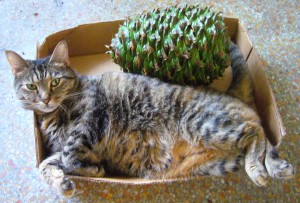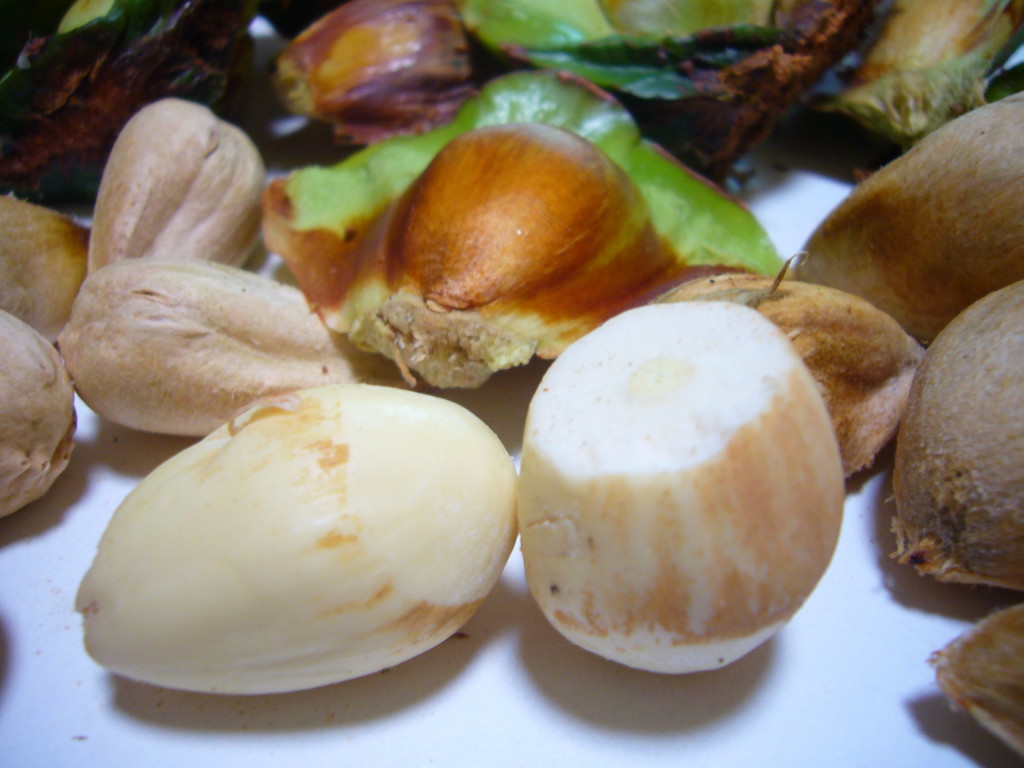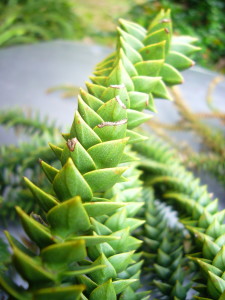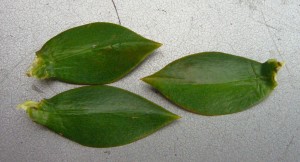The Australian Aboriginals knew a good thing when they tasted it. So did the immigrants. It’s hard to find anyone who doesn’t like the taste of Bunya Pine nuts. But you will find people who don’t like to clean up after it because the ancient species sheds sharp leaves and heavy cones.

The Bunya cone may be prickly but Cous Cous holds on to her prime napping space. Photo by Green Deane
As a well-fed kitty Cous Cous, right, doesn’t get too excited over wild food that can’t run. She weights 10 pounds and sharing the box with her is a 6.5 pound edible Bunya Pine cone. The Bunya Pine is a close relative to the Monkey Puzzle Tree which produces a similar edible fruit except rounder and more pocupine looking. And it’s a stretch to call them pines or the fruit “cones” but it will do. The tree, Araucaria bidwillii (air-ah-KAIR-ee-uh bid-WILL-ee-eye) is native to Australia and was prominent in Aboriginal culture. They would stop wars for its harvest. the Bunya has been exported over the world for a few centuries. It’s naturalized in south Florida but can be found in landscaping in warm areas of the United States and elsewhere. None have made the official maps locally though they are naturalized locally.
My friend Marabou (see Yam Harvest on You Tube) tipped me off to where there was one dropping cones so I had to take a look and taste. And dropping is the lethal word. A six-pound cone dropping 50 feet or more easily has enough impact to kill a person. A couple in New Zealand in April 2012 were hit by a watermelon size cone as they strolled hand-in-hand in a botanical garden there. It fortunately landed between them damaging shoulders and arms rather than causing fatal concussions. They did require some hospitalization.
In its native range the tree can grow taller than 150 feet. Around the age of 14 begins to produce cones which take up to 18 months to mature. They fruit every two to three years though three years is favored. Like the Monkey Puzzle Tree, which reportedlyy grows locally, when the cones are dropped the seeds inside are ready to eat. There’s 30 to 100 seeds per cone whereas 50 is closer to average. They can be eaten raw, boiled or lightly roasted (be careful if you roast them in their shell, they can pop!) The nuts can be deep fired or used in stuffing. Raw the texture is crispy-ish with a soft crunch. Cooked the texture is like a cooked chestnut as is the flavor. Uncooked they taste more like raw peanuts to me. The left-over shell (and wood) is used to grill fish and meat. Indeed, when you roast the nuts in the shell they smell delicious with hints of cinnamon and spice. The germinated seed also produces an underground “earth nut” which has a crisp coconut like flavor. Somewhere I also read the roots are edible but I can’t refind the reference. Seeds weigh around half an ounce each and have about 30 calories. Unlike most nuts they are more starchy than oily. If roasted a long time the become very tough but then they can be ground into a flour-like powder. You can used the shelled nuts like pine nuts and they freeze well for later use.
To see my video on the Bunya Bunya go here.
Green Deane’s “Itemized” Plant Profile: Bunya Pine
IDENTIFICATION: A tall tree with an egg-shaped dome, whorls of gangly branches covered with very sharp leaves. They can draw blood. It is tempting to misidentify the Bunya Pine for the Monkey Puzzle Tree. But there is a fairly easy way to tell them apart besides their cones which are different enough not to be confusing. The Monkey Puzzle Tree has sharp triangle-shaped leaves, pointed at the tip wide at the base. The Bunya Pine leaves, right, are not diamond-shaped but they have a pointed tip and a tapered base and not too wide in the middle. Young leaves tend to be oval and can align themselves in geometric rows. Older leaves tend to be longer and linear.
TIME OF YEAR: In the northern hemisphere around July, in the southen Hemisphere around January, read the beginning of hot summer.
ENVIRONMENT: Good soil and sun. Originally a rainforest tree it will not survive deep cold.
METHOD OF PREPARATION: Nuts raw, boiled, roasted, dried, and sprouting roots as well.





it does not appear that I have already said that/this… !!! Deane, do not all gymnosperms/conifers have an edible embryo ? I’ve tried podocarpus fleshy parts before even ….. i should research nutrition on that! I’ve seen the cuban anole here in Fl eat the purple part before too! Thank you for your site and info!
Hmmmm… I don’t think so…. the Yew is extremely deadly.
I was delighted to see the Bunya Pine highlighted as the first thing I saw upon finding your site. Maybe 15 years ago we seed-napped a cone from a lawn because we were so intrigued by the giant cone. My dad, a green thumb if ever there was one, managed to germinate three plants. Unfortunately all three were planted in poor spots. They are alive and well today, but all will soon be in trouble – one will be taken over by giant bamboo, one is in between giant succulents and the most beautiful one is under a power line. It is only a matter of time before it gets topped. Hopefully we will get a cone to attempt to germinate another plant before they meet a terrible end.
I was recently given a”giant” pine cone and did some research on it. hooray, bunya pines! I just finished extracting the seeds from 2 cones and sampled 1 raw. Odd texture and it tastes like a cross between peruvian corn and chestnuts, I want more! thanks for the info. I have seen several references to removing the “yellow bit” from the center, any idea why?
Yellow bit? I’ve eaten it, raw and cooked, never removed the yellow bit. I’ll have to try it to see if it makes any appreciable difference. There are a couple of other edibles in which one does remove the yellow bit… tulips bulbs (absolutely necessary one remove the yellow bit) and American lotus seeds. In the lotus the yellow bit is quite bitter.
Greetings. I am currently doing an article on the Bunya but can’t find any reliable nutritional data. Anyone found anything other than the (banned site) entry?
Several Australian sites have nutritional information.
Does anyone have a good use for the dead pine leaves or the best way of disposing them. I have two very large bunya pines and they drop quite a lot of leaves.
Now that’s an interesting problem. They are indeed difficult to deal with. Do you eat the bunya pine nuts?
They are great for keeping dogs, chooks and bushturkeys out of my garden as you may know they are horrible to tread on.
Have not been able to harvest them as the litter from the leaves are too deep and too spikey.
Finally got a couple of cones and now harvesting the nuts. What is the best way to cook them?
I think roasting is the best way.
Thanks. Will give that a go.
Love your site and easy to read style, thank you.
re a reference to eating the roots, try Christopher Earl’s site (http://www.conifers.org/ar/Araucaria_bidwillii.php) – he quotes
Huth, J. 2002. Introducing The Bunya Pine, A Noble Denizen Of The Scrub. Queensland Review 9(2): 7-20. Cheers.
Hey Deane, after attending a class earlier this year at Mead Gardens, you tipped me off to a bunya pine in my area off south orange ave. Today I was passing buy and was happy to see the cones on the ground. After a few blows with a hammer I was able to extract the seed from the shell. Going to give them a roast and do a bunya pesto with some fresh basil. Thanks Deane!
I like to know if somebody have some seeds to exchange whit me?
I can’t find any place who will sell a whole one of these giant cones, I just want it because it’s unique, to put on a shelf. All searches result in fossilized cones or just the nuts/seeds for eating or planting. I’m in Washington state USA, near Seattle. Thanks for any leads!
rhgrafix@rhgrafix.com
I have one of these in my front yard. I have been wondering what it was for years now and have finally taken the time to sit down and identify it! This was a great article, thank you. I am going to try and germinate some of these seeds, do you know if seeds from 3 years ago will be viable? I’ve been using this cone as a doorstop.
You can try but they dry out fairly quick.
The best tasting Bunya nuts are when you climb the tree and pick the Bunya cones about one to two weeks before they fall they then tast like water chest nuts very sweet and full of sugar. Once they fall to the ground the sugars turn more to starch,good to grind up and make flower and damper out of. The real name of the Bunya tree is Bunny Bunny in Aboriginal.
So I live near Houston and we recently had a week of below freezing weather and I’m worried about my Bunya tree. It looks dead, do you think I should have it cut down or wait to see if it comes back. It’s very brown
i extracted some grey powder from some dried bunya pine nuts…. edible or not?